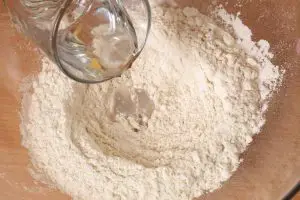While using the technique known as autolyse isn’t recommended for all types of bread, it is something that can make your bread easier to work with, easier to get into the right shape, and give it better rise, texture, and, of course, flavor. And the process itself is simple. All you have to do is mix your flour and water in a bowl until there is no dry flour remaining.
At this point, you should resist the natural temptation to knead the mixture; instead, just mix it with a spoon until it is mixed thoroughly and no dry dough remains. Next, cover the bowl, put it in a warm place, and leave it there from 20 minutes to around three hours.
How Does Autolysing Work?
When you’re letting the dough rest, the gluten starts to develop and the simple sugars start forming as the starch is broken down. If you were to look at the dough during this process, you certainly wouldn’t notice that anything was happening, but there is actually a lot going on in this phase. In fact, as soon as the process is complete and you start handling the dough, you’ll notice that the dough is now smoother and more elastic, making the rest of the bread-making process a breeze.
When the flour absorbs the water, it becomes fully hydrated. When this happens, enzymes in the flour are activated, which stimulates the proteins to start developing gluten. While this is happening, other enzymes are starting to break the starch down into simple sugars, and those sugars will feed the yeast during the bulk prove process.
All of this happens during regular bread-making as well, but when it happens before the kneading is done, as in the autolyse process, it results in bread that tastes better, looks better, and requires less kneading time later on in the process.
How Long Should I Autolyse?
While the autolyse stage does a lot for the texture and taste of your bread, the decision of how long to autolyse isn’t cut and dry. The general recommendation is no more than two to three hours, but a lot of that depends on the type of flour you’re using and the type of bread that you want in the end.
If you don’t have a lot of time to make your bread, you can autolyse it for just 15 to 30 minutes, which is certainly better than not doing this at all. That being said, some general rules regarding autolysing and flour types include the following:
- If you’re using spelt flour, it’s best to skip the autolyse phase altogether
- If you’re using flour with a high percentage of whole wheat, two to four hours of autolysing is usually required
- For sourdough bread, you can autolyse it overnight if you like
- Bread made with stone-ground flour usually needs longer autolyse times
- For bread made with white flour, an autolyse time of one hour is usually recommended
The autolyse process is usually associated only with sourdough bread, but as you can see, other types of bread also benefit from it.
Other things to remember include: (1) if you autolyse for too long, the dough can be too sticky and weak; and (2) make sure that you only mix the flour and water when you autolyse, and no salt, starter, yeast, etc. You might also have to experiment with your particular type of dough to get it right. This is not an exact science and there are no set rules for how long to autolyse.
So, in answer to the question, can I autolyse overnight, the answer is: it depends. Autolysing for too long makes the dough weak and overly sticky. The tips mentioned above should help, but the bottom line is that you can indeed autolyse for long periods of time in many cases, even overnight in some situations. The type of flour you’re using has a lot to do with the answer to this question.
When to Autolyse
So while there are few hard-and-fast rules for when you should autolyse, there are still situations when it’s a good idea to utilize this process. Autolysing is recommended when:
- You want additional extensibility
- You’re using flour with a high percentage of protein
- You’re mixing the dough by hand
- You’re using flour with a high percentage of whole wheat
- You want to enjoy maximum flavor in your dough at any cost
Sourdough bread, baguettes, and even pizza dough can be autolysed, although the times may vary. Certainly, high-protein and whole-wheat breads can benefit from the autolyse process, as well as bread that is being mixed by hand.
When Not to Autolyse
Just as there are situations when autolysing is a good idea, there are also times when it isn’t. You might not want to autolyse when:
- The flour you’re using has a low falling number
- It may add complexity to your baking schedule
- You’re using a flour with a high percentage of freshly milled whole grain
- You’re using a flour with a high percentage that is extensible, such as spelt
Bottom line: you have to look at several things when you’re deciding whether or not to autolyse during the bread-making process. None of the features should be taken alone. You have to look at everything together before making a decision to autolyse or not.
Conclusion
There are many benefits to the autolyse phase when making bread, including a reduced mixing time, better flavor and color preservation, increased extensibility, and, of course, great texture and rise, making every bite you take chewy and delicious. This is a process worth looking into when you love making homemade bread.






